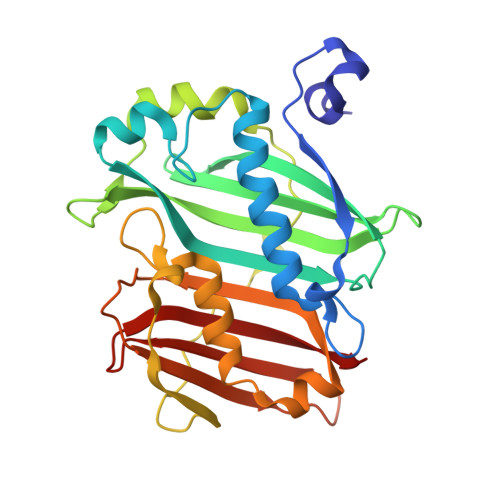Structural Insight into Acyl-ACP Thioesterase toward Substrate Specificity Design.
Feng, Y., Wang, Y., Liu, J., Liu, Y., Cao, X., Xue, S.(2017) ACS Chem Biol 12: 2830-2836
- PubMed: 28991437
- DOI: https://doi.org/10.1021/acschembio.7b00641
- Primary Citation of Related Structures:
5X04 - PubMed Abstract:
Acyl-ACP thioesterase (TE) catalyzes the hydrolysis of thioester bonds during type II fatty acid synthesis and directly determines fatty acid chain length. Most TEs are responsible for recognition of 16:0 and 18:1 substrates, while specific TEs interrupt acyl-ACP elongation at C8-C14. However, the acyl selection mechanism of TE has not been thoroughly elucidated to date. In this study, the crystal structure of the C12-specific thioesterase FatB from Umbellularia californica, which consists of two independent hotdog domains, was determined. An uncanonical Asp-His-Glu catalytic network was identified on the C-terminal hotdog domain, whereas the substrate binding pocket was determined to be on the N-terminal hotdog domain. Moreover, we elucidated UcFatB's substrate selection mechanism, which is accommodated by several unconservative amino acids on the β5, β2, and β4 sheets and enclosed by T137 on the α1 helix. On this basis, the C12-specific TE was rationally redesigned toward C14 selectivity by tuning the substrate binding pocket capacity. The T137G mutant demonstrated comparative relative activity on C14 substrates compared to C12 substrates in vitro. Furthermore, the reconstructed UcFatB_T137G achieved C14 fatty acid content up to 40% in contrast to 10% C14 from the wild type in engineered E. coli cells. The unraveled substrate selection mechanism of TE provides a new strategy for tailoring fatty acid synthesis.
Organizational Affiliation:
Marine Bioengineering Group, Dalian Institute of Chemical Physics, Chinese Academy of Sciences , Dalian 116023, China.














